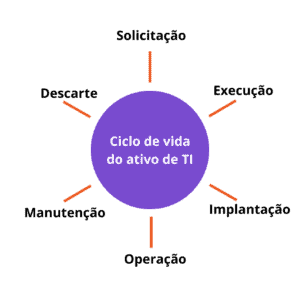IT Asset Management is an essential strategic practice for companies seeking control, efficiency, and governance over their technological resources. With the advancement of cloud solutions, mobility, and the increasing complexity of IT environments, adopting a structured approach through ITAM software has become indispensable. ITAM is not just about inventorying equipment or licenses, but rather ensuring that each IT asset—physical or digital—is aligned with business objectives, generating value at every stage of its lifecycle. In this context, relying on robust ITAM solutions allows you to reduce risks, improve investment predictability, and support smarter decisions about asset acquisition, use, and disposal.
By implementing an effective information technology asset management strategy, organizations have the opportunity to improve their operational efficiency, increase security levels, and reduce financial costs. Additionally, IT asset management can help companies maintain regulatory compliance and enable them to make informed decisions regarding the acquisition, maintenance, and updating of their technology assets. IT asset management represents a fundamental element in today’s business management, capable of optimizing the value of technology investments.
Types of IT Asset Management
Generally speaking, IT assets can be classified into one or more of the following categories: physical, software, hardware, mobile, and cloud. ITAM was created to ensure the successful deployment and ongoing support of these assets.
There are three main types of IT asset management:
Software: This type of IT asset management is a bit more complex than the others, as it involves aspects such as compliance requirements, licensing, shadow IT, and IoT. Software assets need to be continuously monitored and reviewed, and they must be flexible enough to follow requirements and meet the demands of a constantly changing market.
Hardware: Physical hardware also plays a fundamental role in an organization’s IT ecosystem. These physical assets include computers, printers, copiers, laptops, mobile devices, servers, and any other hardware used for data management within the company.
Cloud: ITAM monitors the cost and usage of cloud resources, including SaaS (Software as a Service), IaaS (Infrastructure as a Service), and PaaS (Platform as a Service) . All of these resources are considered assets to be managed for cost and compliance in ITAM.
ISO Standards for IT Asset Management
ISO (International Organization for Standardization) has created an official family of standards for IT asset management, known as ISO 19770, which consists of five parts:
- ISO/IEC 19770-1: Describes recommended practices for managing an enterprise’s IT assets. Organizations can use this standard to demonstrate that they are following IT asset management best practices and meeting governance requirements to support IT activities.
- ISO/IEC 19770-2: Helps companies identify software programs on specific devices using a standard for software identification.
- ISO/IEC 19770-3: Details the attributions associated with software and the method of measuring its consumption.
- ISO/IEC 19770-4: Enables standardized reporting on resource usage. This is particularly important when managing more complex software licenses and cloud-based software and hardware.
- ISO/IEC 19770-5: Provides an overview of ISO standards and vocabulary for IT asset management.
The IT Asset Lifecycle
The IT asset lifecycle is one of the pillars of effective IT asset management. It encompasses all stages an asset goes through: from planning and acquisition, through implementation, monitoring, and maintenance, to disposal or replacement. Proper ITAM software allows you to accurately map and control these phases, promoting transparency and governance. This process avoids unnecessary acquisitions, facilitates audits, and ensures efficient use of resources. By adopting ITAM solutions integrated into the IT ecosystem, companies can keep their infrastructure optimized and in compliance with internal policies and external regulations.
IT asset management follows a lifecycle that involves several stages, such as Request, Execution, Deployment, Operation, Maintenance, and Disposal. Each of these stages is crucial to ensuring that IT assets are managed effectively and meet the company’s needs.
The  first step is the request , where the company’s IT needs are assessed and the requirements for IT assets are defined, including hardware and software standards and the creation of a budget for acquisition and maintenance.
first step is the request , where the company’s IT needs are assessed and the requirements for IT assets are defined, including hardware and software standards and the creation of a budget for acquisition and maintenance.
In the second stage, execution occurs , where IT assets are purchased from selected suppliers and negotiated through purchase contracts.
The third stage is deployment , where the installation and configuration of the acquired IT assets takes place, which may include the installation of hardware, software and network configuration.
The fourth stage is Operation , where IT assets are used daily for business purposes, managing servers, providing technical support to end users, and maintaining a stable and secure network.
The fifth stage is Maintenance , where preventive and corrective maintenance is performed to ensure that IT assets continue to function properly and are always up to date, including installing security patches, updating software, and repairing damaged hardware.
Finally, the sixth stage is Disposal , where the secure removal of IT assets at the end of their useful life occurs, including the recycling or secure disposal of hardware and the secure removal of sensitive data stored on IT assets.
It’s important to note that when it comes to hardware, “inventory” can be included as a separate phase to ensure proper control and management of IT assets. Successfully completing this lifecycle is critical to effectively managing a company’s IT assets and ensuring they are used safely and efficiently.
Equipment check-in/check-out
Maintaining proper control of vital equipment is essential for efficient asset management. To achieve this, it’s important to have a centralized and detailed system for tracking and managing equipment. This system should allow authorized users to request asset loans and include fields that identify important information, such as the person responsible for the asset, the location to which it will be supplied, the asset model, the expected period of use, and the justification for the asset’s need. Having a system for tracking and managing vital equipment helps ensure that assets are utilized appropriately and efficiently.
Know who has what
Effective equipment loan management is important to ensure accounting for all assets and to ensure clarity about who is using what and for how long. However, asset discovery can provide additional information about a company’s devices beyond what is expected, such as their configurations and the users who use them. Discovery and inventory management should be performed in conjunction with the implementation of automation so that all relevant information is automatically entered into a database, facilitating review.
Asset location tracking
Understanding who owns assets, as well as their availability, is crucial to effective IT asset management. However, knowing where they are located is equally important. Using technologies like RFID, GPS, or barcode scanning to track asset locations can help ensure they’re in the right place. Additionally, if an asset is deemed missing, location trackers can be invaluable in locating and securing it.
An ITAM repository
The ITAM repository is essential for storing and managing financial, physical, and contractual data about IT assets. However, an effective repository should not only serve as a storage location but also be capable of performing tasks related to IT asset management. It’s important that the repository is integrated with other management tools, such as inventory, software usage, IT service support, change management, configuration management, and purchasing. This integration allows the repository to be automatically updated with accurate and up-to-date information, making IT asset management and decision-making easier.
Hardware and software inventory and usage information
Successful IT asset management is directly linked to the ability to track relevant metrics. It’s crucial to identify which KPIs are prioritized to ensure the correct metrics are tracked. This helps improve asset performance, reduce maintenance and repair costs, and ensure optimal asset utilization and effectiveness. Several common metrics can be tracked, including:
- Costs
- Number of assets
- Licensed/Unlicensed Software
- Underutilized/overutilized licenses
- Expired warranties
- Data import
To ensure ITAM success, it’s crucial to have accurate and up-to-date asset data, which can come from a variety of sources, such as databases, servers, platforms, and solutions. Importing this data into a centralized location is crucial for presenting an accurate picture of the asset portfolio.
Benefits of a well-structured ITAM
Organizations that implement mature IT Asset Management practices see concrete, measurable benefits. According to Gartner, companies that adopt ITAM can reduce software costs by up to 30% in their first year of implementation. In a case study conducted by ServiceNow, a global manufacturing company saved over $4 million by identifying and eliminating underutilized software licenses. Furthermore, the use of ITAM software directly contributes to regulatory compliance, reducing risks related to audits and penalties. By investing in ITAM solutions, companies not only control their assets but also transform their IT department into a true center of operational efficiency and strategic value.
SAM (Software Asset Management)
SAM ( Software Asset Management ) is a set of practices and processes that help companies manage and optimize their software assets. SAM is important because software misuse can lead to legal and financial problems for companies.
Software Asset Management involves identifying all software used by a company and managing licenses to ensure compliance with intellectual property laws. The ultimate goal of SAM is to ensure the company is using its software assets efficiently and cost-effectively.
Software Asset Management is important for companies of all sizes, but it’s especially critical for large companies with large employees and complex systems. SAM can help ensure that companies aren’t purchasing more software licenses than they need and that they’re utilizing their software appropriately and efficiently.
HAM (Hardware Asset Management)
Hardware Asset Management (HAM) is a set of practices and processes that help companies manage and optimize their physical assets. HAM is important because improper or inefficient use of hardware can lead to financial and security problems for companies.
HAM involves identifying and recording all of a company’s hardware assets, as well as managing them throughout their lifecycle, from acquisition to disposal. Its ultimate goal is to ensure that the company is using its hardware assets efficiently and economically, maximizing productivity and minimizing costs.
Hardware Asset Management is especially important for companies that own large amounts of physical assets, including desktops, laptops, servers, and mobile devices. With HAM, companies can monitor and control the use of these assets, ensuring they are being used appropriately and not wasted.
Cloud Resource Management (Cloud Insights)
SaaS
SaaS (Software as a Service) management is the process of overseeing and administering the SaaS applications used by an organization. Effective management involves assessing business needs and selecting suitable SaaS vendors, deploying applications, integrating systems, managing data and security, managing user accounts, and monitoring performance.
Effective SaaS management can help companies maximize the value of their applications by ensuring they meet business needs and are utilized optimally. This can include conducting regular usage and cost-benefit assessments, carefully selecting SaaS vendors, integrating systems to ensure interoperability, and automating routine tasks.
Security is a key consideration in SaaS management, as many SaaS applications store critical company data in the cloud. It’s important to ensure the security of SaaS applications and protect company data from unauthorized access or security breaches. This may include implementing data security policies such as multi-factor authentication, data encryption, regular backups, and monitoring for suspicious activity.
Another critical aspect of SaaS management is user account management. This involves controlling access to SaaS applications, adding or removing users, monitoring usage, and analyzing trends to ensure users are getting the most value from the SaaS applications they use.
Finally, SaaS management also includes monitoring the performance of SaaS applications. This includes measuring application availability and uptime, as well as analyzing performance to identify bottlenecks and opportunities for improvement.
IaaS
The Infrastructure as a Service (IaaS) model refers to hosting computing resources in a cloud environment rather than in a traditional data center. Effective IaaS management involves monitoring the use of available cloud computing resources, such as storage capacity and processing power. This includes the ability to scale up, adding or removing resources according to the organization’s needs, as well as the ability to monitor usage to identify trends and predict future needs. IaaS management may also involve implementing security policies to protect data and applications hosted in the cloud, as well as monitoring performance to ensure resources are being used effectively and efficiently.
PaaS
Platform as a Service is a cloud computing model that provides a cloud-based development and deployment environment for building applications. It allows developers to build and deploy applications without having to manage the underlying infrastructure. PaaS management includes carefully selecting a PaaS provider, purchasing resources as needed, and monitoring usage to ensure compliance with budgets and usage agreements. Management can also include deploying and configuring applications, integrating with other cloud services, and monitoring performance to ensure applications are functioning properly. Additionally, PaaS management can also involve implementing security policies to ensure application and customer data are protected from external threats.
Benefits of IT Asset Management
Presents a single source
IT asset management aims to create an organized and efficient environment. IT assets are often monitored and tracked across multiple sources, without a clear owner or centralized tool to consolidate all information. ITAM helps solve this problem by providing a system that consolidates asset data, eliminates the need to manually track artifacts, monitors usage, and interprets asset dependencies more efficiently. This results in a more organized and efficient environment, allowing companies to manage their IT assets more easily and effectively.
Improves utilization, reduces risks and reduces waste
With asset management, information is updated regularly, allowing teams to identify and eliminate unnecessary or underutilized assets, which can lead to more efficient resource utilization and, therefore, reduced waste. Additionally, asset control helps ensure that safety and compliance requirements are met, reducing the risk of regulatory penalties associated with safety violations or noncompliance.
Increases productivity without losing reliability
As technology teams embrace DevOps and SRE principles, asset management tools become increasingly important. With increased reliance on infrastructure and platform services, effective asset management is crucial, enabling better management of resource consumption and utilization.
Supports business and IT practices and empowers teams
Asset management supports ITSM and ITIL processes , including change, incident, and problem management. With accurate information readily available, teams can move faster and better anticipate impacts before they occur. This approach is also useful for HR departments for onboarding and offboarding, finance for asset tracking, security for vulnerability remediation, and operations management for discovering critical assets and their dependencies.
Reduces costs through constant analysis
Constant analysis and asset consolidation can provide valuable insight into resource consumption, including licenses, instances, and other resources that may be underutilized or overused. This practice helps identify whether resources are consuming more money than necessary and enables informed decisions about reducing costs and increasing operational efficiency.
What is an IT Asset Management database?
The three components
In the physical component, information is often collected through manual processes, such as using barcode readers or RFID systems. This data collection method aims to identify what is deployed, what may be in stock, and what is scheduled for decommissioning.
The financial component of the ITAM database is typically obtained from systems or purchase orders. It includes the purchase order number, quantity, make and model, depreciation, supplier name, and cost center. Collecting and tracking this information is essential to providing accurate data on total cost of ownership, ROI, and budgets allocated to projects and services.
Finally, the contractual component consists of data collected from resellers, suppliers, or contract management systems. This information includes the final version of a contract, license assignment, number of devices, purchase price, supplier SKU, service levels, and maintenance. This information is important for contract management and aids in decision-making regarding acquisitions and renewals.
IT Asset Management Best Practices
- Start with executive buy-in
- Start a team to pilot the project
- Define essential assets
- Identify cloud resources
- Determine methods for data detection and integration
- Use a lifecycle approach
- Be proactive in your tracking initiatives and monitor them continuously to avoid over-deployment
- Decide whether to use a CMDB
- Automate as much as possible
- Integrate and make data available to all IT
- Know your software licenses
- Gather feedback for continuous improvement
- Involve other teams in feedback
How do I know if ITAM Solutions are ideal for my organization?
There are several reasons why ITAM can support your organization, such as:
Do you want to save money?
Optimizing spending on software, infrastructure, and platform services is a key cost-cutting strategy. By adopting best practices for optimizing software licenses and asset utilization, organizations can reduce spending by up to 30%.
Do you rely on spreadsheets?
Even today, many companies rely on spreadsheets to track their assets. However, these spreadsheets aren’t completely accurate. Furthermore, they create data silos that make it difficult for all authorized users to access the same up-to-date information.
Is it difficult to keep up with the pace of change?
Tracking IT assets can be a daunting task, as these assets are constantly in motion. Managing issues like loss, replacement, decommissioning, and the receipt of new assets can be quite chaotic, requiring meticulous attention to detail.
Shadow IT is a reality
Shadow IT refers to applications, licenses, and other IT assets that are being acquired and used without the IT team’s knowledge. Centralized ITAM software keeps IT on top of everything and prevents overspending, risk, and noncompliance. Shadow IT is a reality that almost all modern companies face. How you manage it will make a difference in the level of control needed to reduce risk and expense.
Would you like to learn more about implementing an effective ITAM system for your company? Contact us now to speak with an IT asset management specialist and learn how we can help you reduce costs, improve operational efficiency, and maximize your return on technology investment. Click to speak with a specialist.


